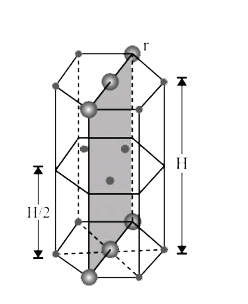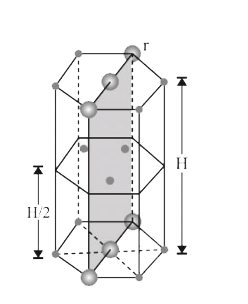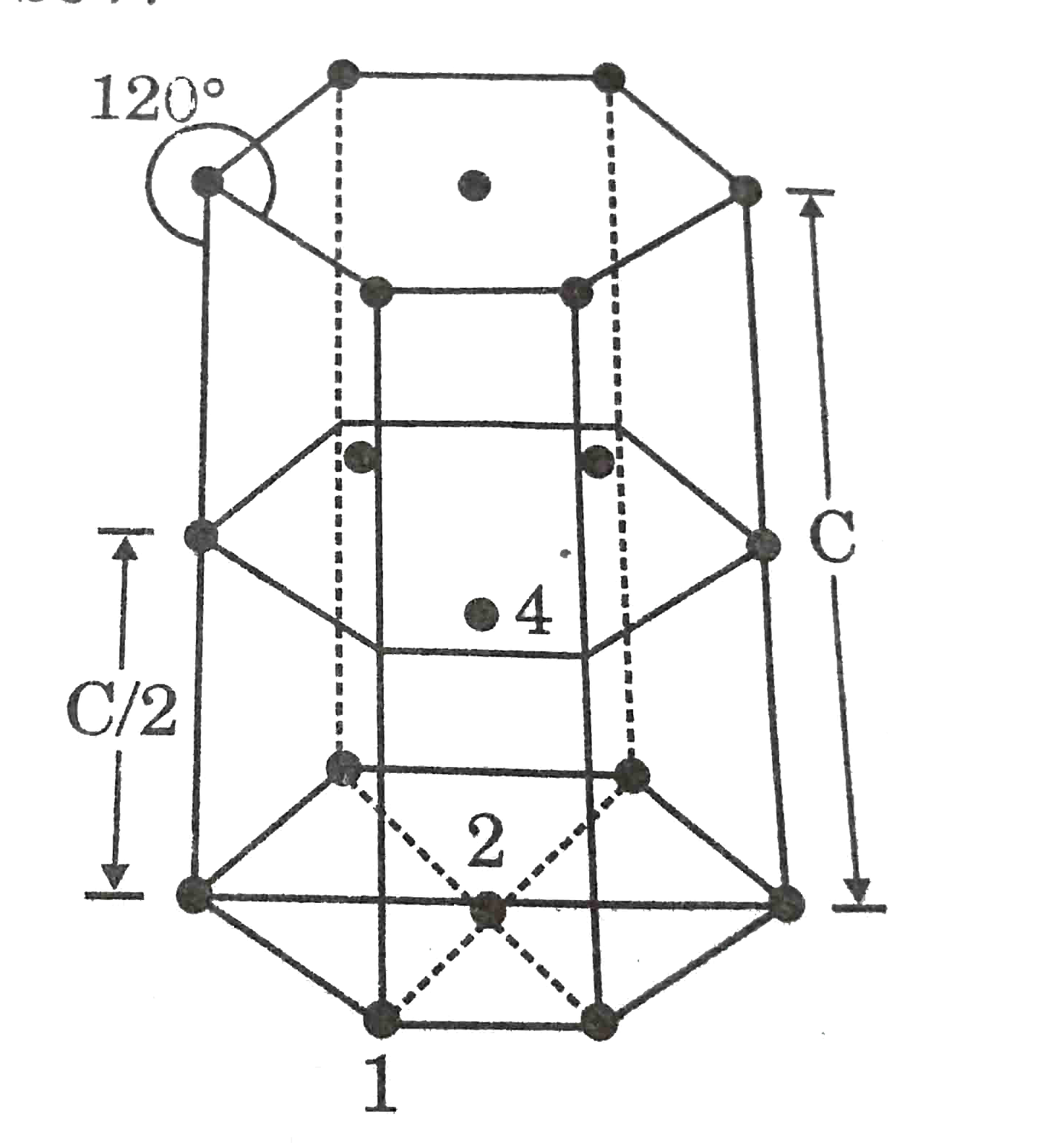In a hexaonal system system of cycstals, a frequently encountered arrangement of atoms is described as a hexagonal prism. Here, the top and bottom of the cell are refular hexagons, and three atoms are sandwiched in between them. A space-cilling model of this structure, called hexagonal close-paked is constituted of a sphere on a flat surface surrounded in the same plane by six identical spheres as closely as possible. Three spherres are then placed overt the first layer so that they toych each other and represent the second layer so that they toych each other and present the second layer. Each one of the three spheres touches three spheres of the bottom layer. Finally, the second layer is convered with a third layer identical to the bottom layer in relative position. Assume the radius of every sphere to be r.
The number of atom in this hcp unit cell is
4
6
12
17
The correct Answer is:B
To find the number of atoms in a hexagonal close-packed (hcp) unit cell, we can follow these steps:
1. Understanding the Structure:
- In the hcp structure, there are three layers of atoms. The top and bottom layers are hexagonal, and there is one layer of atoms sandwiched in between.
2. Atoms in the Bottom Layer:
- The bottom layer consists of atoms located at the corners of the hexagon and one atom at the center of the hexagon.
- There are 6 corner atoms and 1 face-centered atom (the center atom).
3. Contribution of Corner Atoms:
- Each corner atom is shared by 6 unit cells. Therefore, the contribution of each corner atom to the unit cell is 16.
- Total contribution from the corner atoms:
6 corners×16=1 atom
4. Contribution of Face-Centered Atom:
- The face-centered atom contributes half of its volume to the unit cell because it is shared with another unit cell.
- Therefore, the contribution from the face-centered atom is:
1 atom×12=0.5 atom
5. Atoms in the Middle Layer:
- The middle layer contains 3 atoms. These atoms are not shared with any other unit cell, so they contribute fully to the unit cell.
- Contribution from the middle layer:
3 atoms=3 atoms
6. Total Number of Atoms in the Unit Cell:
- Now, we can sum the contributions from all layers:
Total atoms=Atoms from corners+Atoms from face center+Atoms from middle layer
Total atoms=1+0.5+3=4.5 atoms
7. Correction for Face-Centered Atoms:
- Since there are two face-centered atoms (one on the top and one on the bottom), we need to account for both:
Total atoms=1+1+3=5 atoms
8. Final Count:
- However, in the hcp structure, we need to consider that the top and bottom layers are identical to the bottom layer, thus the total number of atoms in an hcp unit cell is actually:
Total atoms=2 (from top and bottom layers)+3 (from middle layer)=6 atoms
Conclusion:
The total number of atoms in the hexagonal close-packed (hcp) unit cell is 6.
- In the hcp structure, there are three layers of atoms. The top and bottom layers are hexagonal, and there is one layer of atoms sandwiched in between.
- The bottom layer consists of atoms located at the corners of the hexagon and one atom at the center of the hexagon.
- There are 6 corner atoms and 1 face-centered atom (the center atom).
- Each corner atom is shared by 6 unit cells. Therefore, the contribution of each corner atom to the unit cell is 16.
- Total contribution from the corner atoms:
6 corners×16=1 atom
- The face-centered atom contributes half of its volume to the unit cell because it is shared with another unit cell.
- Therefore, the contribution from the face-centered atom is:
1 atom×12=0.5 atom
- The middle layer contains 3 atoms. These atoms are not shared with any other unit cell, so they contribute fully to the unit cell.
- Contribution from the middle layer:
3 atoms=3 atoms
- Now, we can sum the contributions from all layers:
Total atoms=Atoms from corners+Atoms from face center+Atoms from middle layer
Total atoms=1+0.5+3=4.5 atoms
- Since there are two face-centered atoms (one on the top and one on the bottom), we need to account for both:
Total atoms=1+1+3=5 atoms
- However, in the hcp structure, we need to consider that the top and bottom layers are identical to the bottom layer, thus the total number of atoms in an hcp unit cell is actually:
Total atoms=2 (from top and bottom layers)+3 (from middle layer)=6 atoms
The total number of atoms in the hexagonal close-packed (hcp) unit cell is 6.
Similar Questions
In a hexagonal system system of crystals, a frequently encountered arrangement of atoms is described as a hexagonal prism. Here, the top and bottom of the cell are regular hexagons, and three atoms are sandwiched in between them. A space-cilling model of this structure, called hexagonal close-packed is constituted of a sphere on a flat surface surrounded in the same plane by six identical spheres as closely as possible. Three spheres are then placed overt the first layer so that they touch each other and represent the second layer so that they touch each other and present the second layer. Each one of the three spheres touches three spheres of the bottom layer. Finally, the second layer is converted with a third layer identical to the bottom layer in relative position. Assume the radius of every sphere to be r.
The number of atom in this hcp unit cell is
(a)4
(b)6
(c)12
(d)17
View SolutionIn a hexaonal system system of cycstals, a frequently encountered arrangement of atoms is described as a hexagonal prism. Here, the top and bottom of the cell are refular hexagons, and three atoms are sandwiched in between them. A space-cilling model of this structure, called hexagonal close-paked is constituted of a sphere on a flat surface surrounded in the same plane by six identical spheres as closely as possible. Three spherres are then placed overt the first layer so that they toych each other and represent the second layer so that they toych each other and present the second layer. Each one of the three spheres touches three spheres of the bottom layer. Finally, the second layer is convered with a third layer identical to the bottom layer in relative position. Assume the radius of every sphere to be r.
The empty space in this hcp unit cell is
(a)74%
(b)48.6%
(c)32%
(d)26%
View SolutionIn hexagonal systems of crystals, a frequently encountered arrangement of atoms is described as a hexagonal prism. Here, the top and bottom of the cell are regular hexagons and three atoms are sandwiched in between them. A space-filling model of this structure, called hexagonal close-packed (HCP), is constituted of a sphere on a flat surface surrounded in the same plane by six identical spheres as closely as possible. Three spheres are then placed over the first layer so that they touch each other and represent the second layer. Each one of these three spheres touches three spheres of the bottom layer. Finally, the second layer is covered with a third layer that is identical to the bottom layer in relative position. Assume radius of every sphere to be ‘r’.
The empty space in this HCP unit cell is :

View SolutionIn hexagonal systems of crystals, a frequently encountered arrangement of atoms is described as a hexagonal prism. Here, the top and bottom of the cell are regular hexagons and three atoms are sandwiched in between them. A space-filling model of this structure, called hexagonal close-packed (HCP), is constituted of a sphere on a flat surface surrounded in the same plane by six identical spheres as closely as possible. Three spheres are then placed over the first layer so that they touch each other and represent the second layer. Each one of these three spheres touches three spheres of the bottom layer. Finally, the second layer is covered with a third layer that is identical to the bottom layer in relative position. Assume radius of every sphere to be ‘r’.
The volume of this HCP unit cell is

View SolutionIn hexagonal system of crystals, a frequently encountered arrangement of atoms is described as a hexagonal prism. Here, the top and bottom of the cell are regular hexagons and three atoms are sandwiched in between them. A space -filling model of this structure, called hexagonal close-packed (HCP), is consituted of a sphere on a flat surface surrouneded in the same plane by six identical spheres as closely possible. Three sphere are then palces over the first layer so that they touch each other and represent second layer is covered with third layer that is identical to the bottom layer in relative position. Assume radius of enery sphere to be r.

The number of atoms in the HPC unit cell is :
View SolutionIn a hexagonal crystal:
View SolutionThe number of atoms present in a hexagonal close-packed unit cell is:
View SolutionThe number of atoms present in a hexagonal close-packed unit cell is:
View SolutionWhich of the following describes the hexagonal close packed arrangement of spheres ?
View SolutionWhich of the following describes the hexagonal close packed arrangement of spheres ?
View Solution
